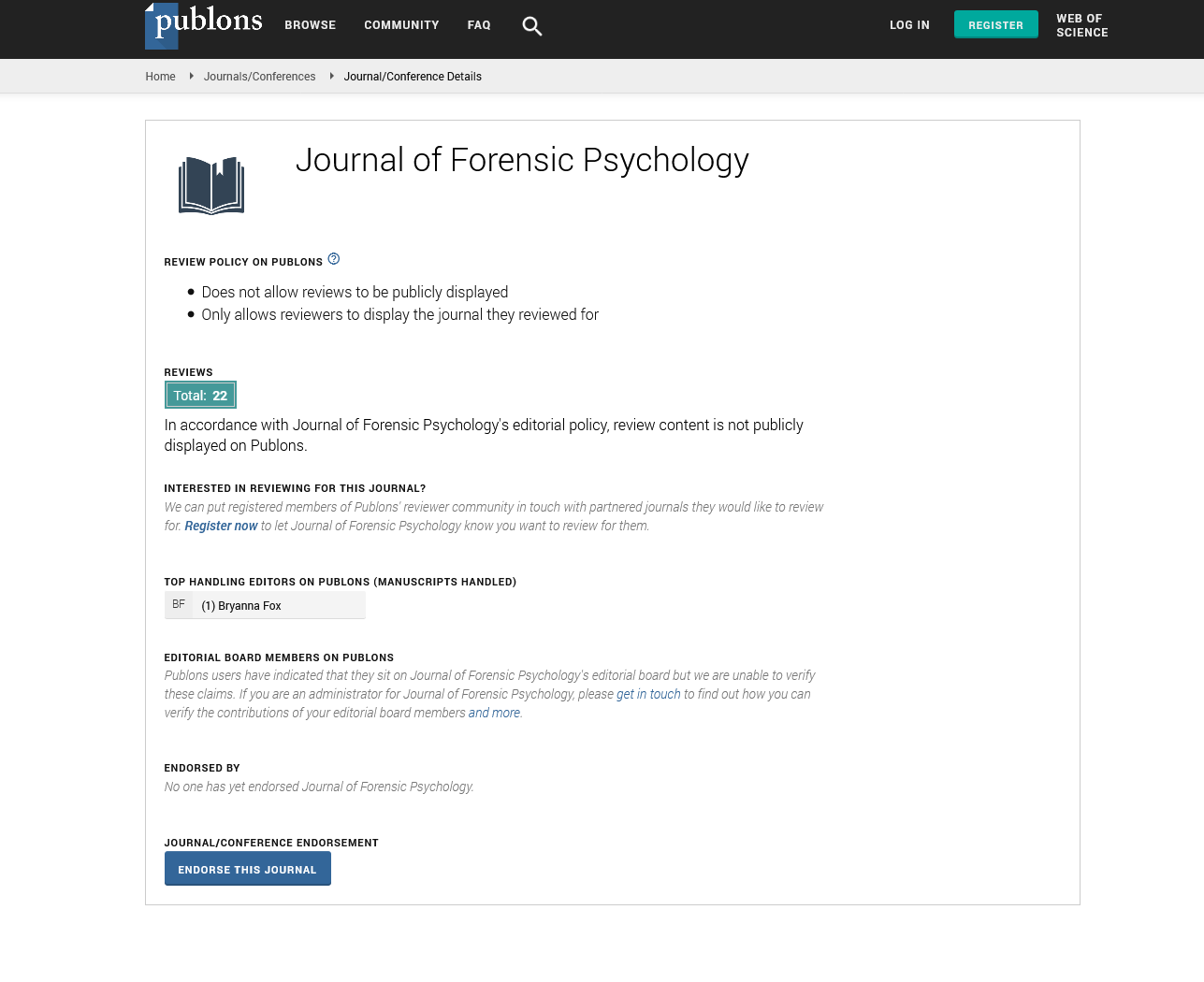Indexed In
- RefSeek
- Hamdard University
- EBSCO A-Z
- Publons
- Geneva Foundation for Medical Education and Research
- Euro Pub
- Google Scholar
Useful Links
Share This Page
Journal Flyer

Open Access Journals
- Agri and Aquaculture
- Biochemistry
- Bioinformatics & Systems Biology
- Business & Management
- Chemistry
- Clinical Sciences
- Engineering
- Food & Nutrition
- General Science
- Genetics & Molecular Biology
- Immunology & Microbiology
- Medical Sciences
- Neuroscience & Psychology
- Nursing & Health Care
- Pharmaceutical Sciences
Perspective - (2022) Volume 7, Issue 2
Understanding and Impact of Trauma
Catrin Lynn*Received: 28-Jan-2022, Manuscript No. JFPY-22-15772; Editor assigned: 31-Jan-2022, Pre QC No. JFPY-22-15772(PQ); Reviewed: 14-Feb-2022, QC No. JFPY-22-15772; Revised: 18-Feb-2022, Manuscript No. JFPY-22-15772(R); Published: 25-Feb-2022, DOI: 10.35248/2475-319X.22.7.211
Description
Trauma Informed Care (TIC) includes a wide understanding of traumatic stress reactions and common responses to trauma. Doctors need to understand how trauma can affect treatment presentation, the outcome of behavioral health services and engagement.
Trauma, involving one-time, multiple, or long-lasting repetitive events, affects everyone separately. Some persons may clearly display criteria related with Posttraumatic Stress Disorder (PTSD), but many more individuals will exhibit tough responses or consequences that fall outside of analytic criteria. The impact of trauma can be insidious, subtle, or absolute unhelpful. How an event affects an individual depends on many factors, including the type and characteristics of the event(s), characteristics of the individual, developmental processes, the sense of the trauma, and sociocultural issues.
This topic highlights common long and short- term responses to traumatic experiences in the context of persons who may seek behavioral health facilities. Here it mentioned psychological symptoms not represents in the Diagnostic and Statistical Manual of Mental Disorders, and responses associated with trauma that either fall below the verge of mental disorders or replicate resilience. It also notices general disorders associated with traumatic stress. Here the role of culture in defining mental illness, ends by addressing co-occurring mental, particularly PTSD and substance-related disorders explored.
Survivors’ instant reactions in the result of trauma are quite complex and are affected by their own experiences, the convenience of natural supports and healers, their life skills and coping and those of immediate family, and the responses of the larger community in which they live. Although reactions range in severity, even the most severe responses are natural responses to manage trauma they are not a mark of psychopathology. Coping styles vary from action oriented to reflective and from emotionally sensitive to reticent. Clinically, a retort style is less important than the range to which coping efforts successfully allow one to continue necessary activities, regulate emotions sustain self-esteem, and maintain and enjoy interpersonal contacts. Indeed, a past error in traumatic stress psychology, mainly regarding group or mass traumas, was the supposition that all survivors need to express emotions related with trauma and talk about the trauma; recent research specifies that survivors who choose not to process their trauma are just as psychologically strong as those who do. The most recent psychological interrogation approaches emphasize respecting the individual’s style of coping and not valuing one type over another.
Trauma can affect one’s beliefs about the future through loss of hope, limited expectations about life, fear that life will end shortly or early, or expectation that normal life events won’t occur (e.g., admission to education, capability to have a significant and committed relationship, good opportunities for work).
Early reactions to trauma can include exhaustion, sadness, anxiety, confusion, agitation, numbness, dissociation, confusion, physical arousal, and blunted affect. Most responses are usual in that they affect most survivors and are psychologically effective, socially acceptable, and self-limited. Indicators of more severe responses include incessant distress without stages of relative calm or rest, severe dissociation symptoms, and intense intrusive recollections that continue despite a return to safety. Delayed responses to trauma can include sleep disorders, persistent fatigue, nightmares, anxiety focused on flashbacks, fear of recurrence, depression, and avoidance of emotions, sensations, or activities that are associated with the trauma, even remotely.
Conclusion
A variety of reactions are often stated and/or observed after trauma. Most survivors show fast reactions, yet these naturally resolve without severe long-term consequences. This is because most trauma survivors are extremely resilient and develop appropriate coping approaches, including the use of social supports, to deal with the aftermath and effects of trauma. Most recover with time, show negligible distress, and function efficiently across major life areas and developing stages. Even so,clients who show slight impairment may still have subclinical symptoms or symptoms that do not fit analytical criteria for Acute Stress Disorder (ASD) or PTSD. Only a small percentage of people with a history of trauma show impairment and symptoms that meet criteria for trauma-related stress disorders, including mood and anxiety disorders.
Citation: Lynn C (2022) Understanding and Impact of Trauma. J Foren Psy. 7:211.
Copyright: © 2022 Lynn C. This is an open-access article distributed under the terms of the Creative Commons Attribution License, which permits unrestricted use, distribution, and reproduction in any medium, provided the original author and source are credited.

